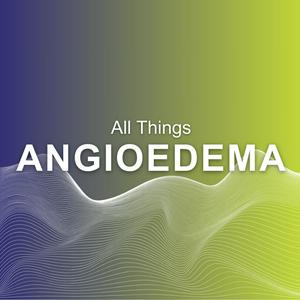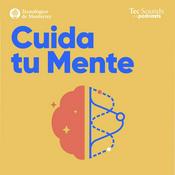All Things Angioedema – Learning about angioedema with Dr. Thomas Buttgereit

45 episodios

What Angioedema Reveals About CSU
23/12/2025 | 18 min
In this episode of All Things Angioedema, Thomas Buttgereit speaks with Dr. Vesna Trajkova, dermatologist and researcher from Skopje, North Macedonia, about the clinical relevance of angioedema in chronic spontaneous urticaria (CSU) and what its presence reveals about disease severity and underlying mechanisms. They discuss:🔹 How common is angioedema in patients with CSU? 🔹 Is angioedema linked to more severe or longer-lasting disease? 🔹 What is the role of autoimmunity and autologous serum skin testing? 🔹 How should these findings influence everyday clinical practice? Dr. Trajkova presents data from her recent study showing that 70% of CSU patients experience angioedema, with the vast majority occurring in those with severe disease. The discussion highlights associations between angioedema, higher disease activity, longer disease duration, and autoimmune markers, emphasizing that angioedema should nobe viewed as a minor accompanying symptom. Together, they explore how recognizing angioedema as a clinically meaningful marker can improve risk stratification, monitoring, and treatment decisions in CSU. Key Learnings from the Episode:Angioedema is highly prevalent in CSU, affecting around 70% of patients the CSU population investigated in the study. The presence of angioedema is strongly associated with severe CSU, occurring in over 80% of severe cases. CSU patients with angioedema tend to have a longer disease duration, indicating a higher cumulative burden. Autoimmune markers and comorbid autoimmune diseases are more frequent in CSU patients with angioedema. Autologous serum skin test positivity shows a trend toward higher angioedema prevalence, supporting an autoimmune component. Angioedema does not merely coexist with CSU but acts as a marker of disease severity and complexity. Routine CSU assessment should actively include angioedema evaluation, not just wheals and itch. Recognizing angioedema can help guide earlier treatment escalation and closer follow-up in clinical practice. Chapters:00:00 Introduction to Angioedema and CSU02:30 Guest Introduction: Vesna Trejkova04:50 Research Rationale and Study Overview10:34 Key Findings on Angioedema in CSU13:15 Study Limitations and Future Directions15:32 Clinical Implications of Research FindingsFeedback form ATA: https://forms.office.com/e/ZWxx3D4Cmr

Rare but Real: Tackling Acquired C1 -Inhibitor Deficiency
25/11/2025 | 18 min
In this episode, Dr. Thomas Buttgereit welcomes Mats de Lange, medical doctor and PhD candidate at Amsterdam UMC, to discuss one of the rarest and most challenging forms of angioedema – acquired angioedema (AAE) due to C1 inhibitor deficiency (AAE-C1INH). They discuss🔹 What causes AAE, and how does it differ from hereditary angioedema? 🔹 Why is treatment still off-label for most patients? 🔹 What did the Amsterdam investigator-initiated trial reveal about Deucrictibant, a new bradykinin B2 receptor antagonist? 🔹 How could this research pave the way for the first approved AAE therapy? Mats de Lange shares insights from his team’s investigator-initiated trial on the long-term use of Deucrictibant, showing remarkable results – three out of four patients remained attack-free for 20 months. The discussion also highlights the unique challenges of studying such an ultra-rare condition and the hope for future phase III trials. Join us as we explore how collaborative research and patient participation are advancing the field of bradykinin-mediated angioedema. Key Learnings from the Episode:Acquired angioedema (AAE) is an extremely rare disorder caused by C1 inhibitor deficiency. Patients often have underlying hematologic diseases, making trials complex. Deucrictibant showed strong efficacy and safety in an investigator-initiated trial. All participants became attack-free during treatment, without major adverse events. Off-label access remains a challenge – approved therapies are urgently needed. Future multi-center studies and regulatory approval could transform patient care. Chapters00:00 Introduction to Angioedema and Guest Introduction03:06 Understanding Acquired Angioedema due to C1 Inhibitor Deficiency06:05 Current Treatment Landscape and Challenges07:16 Investigator-Initiated Trials and Droycriptiband11:05 Trial Design and Patient Characteristics11:52 Promising Results from the Trial13:06 Key Learnings and Future Directions15:44 Next Steps in Research and Treatment ApprovalDo you have suggestions for future episodes? Please provide feedback and offer your suggestions for future topics and expert selection here.Feedback form ATA: https://forms.office.com/e/ZWxx3D4Cmr

Bradykinin or Mast Cells? Decoding ACE inhibitor-induced angioedema
28/10/2025 | 18 min
In this episode, Dr. Thomas Buttgereit welcomes Dr. Alexis Bocquet from the French National Center for Angioedema in Grenoble to discuss one of the most challenging forms of drug-induced angioedema — ACE inhibitor–induced angioedema. They discuss🔹 Why are ACE inhibitors among the most prescribed cardiovascular drugs worldwide? 🔹 How can physicians distinguish bradykinin-mediated from mast-cell-mediated angioedema? 🔹 What are the key risk factors for developing ACE inhibitor–induced angioedema? 🔹 How can the new diagnostic core support clinicians in practice? Dr. Bocquet shares findings from a French multicenter study conducted in Grenoble and Réunion Island, where he and his colleagues identified four clinical criteria that accurately differentiate ACE inhibitor–induced angioedema from other forms. He also explains the score they developed — a five-point tool that predicts diagnosis with more than 90% accuracy — and offers practical advice on treatment, including when to use icatibant or C1 inhibitor concentrate in acute care. Join us for a scientifically rich and practical conversation on how to diagnose and manage one of the most life-threatening but underrecognized types of angioedema. Key Learnings from the Epesode:ACE inhibitors are widely used for heart failure, hypertension, and kidney protection but can rarely cause bradykinin-mediated angioedema. The pathophysiology involves inhibition of bradykinin degradation, leading to increased vascular permeability and swelling. Risk factors include age over 65, female sex, African or Afro-Caribbean ethnicity, concomitant use of NSAIDs, smoking, cardiovascular comorbidities, and genetic variants in bradykinin receptor B2 or aminopeptidase N. In a French bicenter study (Grenoble & Réunion Island, 2019–2022), 126 patients were evaluated for angioedema without hives; 49 were confirmed as ACE inhibitor–induced, and 44 as mast cell-mediated. The four diagnostic factors identified were: No relapse after discontinuation of ACE inhibitor Attack duration longer than 24 hours Hospitalization in intensive care Fewer than three previous angioedema attacks These factors formed the five-point score: 0–2 points → Likely mast cell angioedema 4–5 points → >90% probability of ACE inhibitor–induced angioedema Persistent angioedema after stopping ACE inhibitors usually indicates mast- cell-mediated angioedema or CSU, not ACE inhibitor–induced angioedema. Genetic testing may help rule out hereditary angioedema with normal C1 inhibitor. Tranexamic acid shows little benefit in ACE inhibitor–induced angioedema. Treatment recommendations: Icatibant is first-line off-label therapy with rapid efficacy. C1 inhibitor concentrate is an effective alternative. Both are off-label but justified in life-threatening upper-airway cases.The team plans a national prospective validation of the diagnostic Score for ACE inhibitor-induced anigoedema across France in 2025. Chapters:00:00 Introduction to ACE Inhibitor Induced Angioedema03:31 Understanding ACE Inhibitors and Their Benefits06:00 Pathophysiology and Risk Factors of Angioedema09:02 Research Insights from CRIAC and Study Design11:30 Clinical Features and Diagnosis of Angioedema14:01 Proposed Diagnostic Score for Angioedema16:40 Treatment Options for ACE Inhibitor Induced AngioedemaDo you have suggestions for future episodes? Please provide feedback and offer your suggestions for future topics and expert selection here.Feedback form ATA: https://forms.office.com/e/ZWxx3D4Cmr

When C1 Is Normal: Managing Rare Bradykinin-Mediated Angioedema
30/9/2025 | 18 min
In this episode, Dr. Thomas Buttgereit welcomes Dr. Efrem Eren, immunologist and allergy specialist from the University of Southampton, to discuss practical approaches to diagnosing and treating patients with recurrent angioedema, especially those with normal C1 inhibitor values. They discuss:🔹 How can physicians distinguish histamine- vs. bradykinin-mediated angioedema? 🔹 Why do some patients develop angioedema years after starting ACE inhibitors? 🔹 How can icatibant be used not only as treatment but also as a diagnostic tool? 🔹 What options exist for long-term prophylaxis when standard therapies fail? Dr. Eren shares his clinical framework for approaching difficult cases, including the value of patient education, treatment trials with tranexamic acid or omalizumab, and the growing role of icatibant and kallikrein inhibitors. He also highlights a moving patient story that demonstrates the life-changing impact of correct diagnosis and targeted therapy. Join us for this insightful discussion on how to navigate diagnostic uncertainty, choose treatment strategies, and improve patient outcomes in rare forms of angioedema. Key Learnings from the Episode:Categorization is key: Angioedema can often be grouped into histamine-mediated, mast-cell–bradykinin–mediated, or bradykinin-mediated causes. Diagnostic limitations: Laboratory tools are scarce; bradykinin measurement is not routinely available. Diagnosis often relies on clinical features and treatment response. ACE inhibitor angioedema can appear years after therapy initiation, often requiring a “second hit” to trigger. Treatment trials help guide diagnosis: High-dose antihistamines → mast-cell mediated Steroid responsiveness → mast-cell involvement Omalizumab → effective in some mast-cell angioedema cases Icatibant → valuable for suspected bradykinin-mediated angioedema (also used diagnostically) Tranexamic acid can be effective for some patients with angioedema linked to mast cells. C1 inhibitor concentrate is ineffective in patients with normal C1 levels and function. Patient burden is high, including anxiety, frequent hospital admissions, and restrictions in daily life. Case story: A teenager with unexplained recurrent angioedema gained her independence and normal life back after diagnosis and treatment with icatibant and kallikrein inhibition. Prophylaxis: Kallikrein inhibitors like berotralstat can be used in select patients; responses are typically evaluated over at least 3 months. Objective evidence (photos, symptom scores) is essential for diagnosis and evaluating treatment response. Chapters:00:00 Introduction to Angioedema and Its Challenges02:48 Understanding Angioedema: Types and Diagnosis07:13 Treatment Approaches for Angioedema12:22 Patient Experiences and Impact of Angioedema15:35 Prophylactic Treatments and Future DirectionsDo you have suggestions for future episodes? Please provide feedback and offer your suggestions for future topics and expert selection here.Feedback form ATA: https://forms.office.com/e/ZWxx3D4Cmr

COVID-19 & Angioedema: Insights from Italy
02/9/2025 | 7 min
In this episode, Thomas welcomes Dr. Riccardo Senter, allergist at the University Hospital of Padova and member of the ITACA Network, to discuss the impact of COVID-19 on patients with bradykinin-mediated angioedema — including both hereditary and acquired C1 inhibitor deficiency forms. They discuss:🔹 How did COVID-19 affect angioedema severity, hospitalization rates, and recovery? 🔹 What does new data from the pan-Italian ITACA registry reveal about patient outcomes? 🔹 How do hereditary and acquired angioedema differ in their response to coronavirus infection? 🔹 What role do patient registries and research networks play in supporting rare disease care? Dr. Senter presents survey data from 15 Italian centers, detailing age, sex, disease severity, and COVID-19 outcomes for 52 angioedema patients treated in early 2021. He explains the differences between hereditary and acquired forms, why registries like ITACA are crucial for building robust knowledge, and how collaboration supports better care for rare disease patients. Join us for an insightful discussion on the realities of COVID-19 in angioedema patients — and how international research efforts can drive advancements in diagnosis, management, and patient support. Key Learnings from the Episode:COVID-19 did not lead to increased mortality in angioedema patients; no deaths occurred in the surveyed group. 8% of hereditary angioedema patients had severe COVID-19 requiring hospitalization, but all recovered. Acquired angioedema patients, despite older age, did not experience severe COVID-19 or complications. The ITACA network enabled collecting robust data across many centers, highlighting the role of registries in rare disease research. The distinction between hereditary (genetic deficiency) and acquired (secondary to other diseases like lymphoma) C1 inhibitor deficiency is crucial for clinicians and patients. Collaborative networks and standardized registries improve care and understanding of rare angioedema forms during pandemics. Chapters 00:00 Introduction to Angioedema and COVID-19 03:35 Understanding HAE and Acquired Angioedema Do you have suggestions for future episodes? Please provide feedback and offer your suggestions for future topics and expert selection here.Feedback form ATA: https://forms.office.com/e/ZWxx3D4Cmr
Más podcasts de Educación
Podcasts a la moda de Educación
Acerca de All Things Angioedema – Learning about angioedema with Dr. Thomas Buttgereit
Escucha All Things Angioedema – Learning about angioedema with Dr. Thomas Buttgereit, BBVA Aprendemos juntos y muchos más podcasts de todo el mundo con la aplicación de radio.net

Descarga la app gratuita: radio.net
- Añadir radios y podcasts a favoritos
- Transmisión por Wi-Fi y Bluetooth
- Carplay & Android Auto compatible
- Muchas otras funciones de la app
Descarga la app gratuita: radio.net
- Añadir radios y podcasts a favoritos
- Transmisión por Wi-Fi y Bluetooth
- Carplay & Android Auto compatible
- Muchas otras funciones de la app


All Things Angioedema – Learning about angioedema with Dr. Thomas Buttgereit
Descarga la app,
Escucha.







































